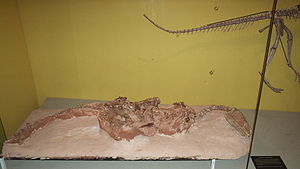Guaibasaurus
| Guaibasaurus | ||||||||||||
|---|---|---|---|---|---|---|---|---|---|---|---|---|

Fossil skeleton of Guaibasaurus |
||||||||||||
| Temporal occurrence | ||||||||||||
| Carnium to Norium ( Upper Triassic ) | ||||||||||||
| 235 to 208.5 million years | ||||||||||||
| Locations | ||||||||||||
|
||||||||||||
| Systematics | ||||||||||||
|
||||||||||||
| Scientific name | ||||||||||||
| Guaibasaurus | ||||||||||||
| Bonaparte , Ferigolo & Ribeiro, 1999 | ||||||||||||
Guaibasaurus was a basal Saurischier , which possibly belonged to the Theropods , but is sometimes also to the Sauropodomorphs or Herrerasauriden. Like Herrerasaurus and other early dinosaurs, it had three fully developed and two receding fingers.
It reached a height of 1.2 meters, a length of 3 meters and a weight of 100 kg.
Bonaparte , Ferigolo and Ribeiro discovered him in 1999 in Brazil ( Caturrita Formation ).
Bonaparte found in 2007 that Saturnalia and Guaibasaurus are very closely related and grouped them together as Guaibasauridae . They were probably ancestors of the Theropoda .
Web links
Commons : Guaibasaurus - collection of images, videos and audio files
literature
- Max C. Langer, Jonathas S. Bittencourt, Cesar L. Schultz: A reassessment of the basal dinosaur Guaibasaurus candelariensis, from the Late Triassic Caturrita Formation of south Brazil. In: Earth and Environmental Science Transactions of the Royal Society of Edinburgh. Vol. 101, Special No. 3/4, 2010, ISSN 1755-6910 , pp. 301-332, doi : 10.1017 / S175569101102007X .